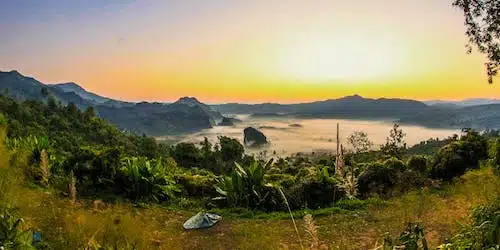Experience the captivating allure of Thailand’s monsoon season, where nature orchestrates a symphony of rain, transforming the landscape into a lush canvas. The southwest and northeast monsoons have an impact on Thailand’s monsoon season, which lasts from May to October and is characterized by torrential rains and sporadic flooding. The season varies across regions, with the south receiving the most rainfall. The monsoon season can lead to floods, but not all areas experience severe damage. Dry spells occur from June to early July due to the northward movement of the ITCZ. If you’re planning on moving to Thailand, here’s all you should know about the Monsoon season.
Monsoon Season Thailand
Thailand experiences a monsoon season, also known as the wet or green season, which is characterized by heavy rains and occasional floods. Unlike other parts of the world, Thailand has three main seasons: hot, not-so-hot, and monsoon. Two monsoons—the southwest monsoon and the northeast monsoon—have an impact on the monsoon season in Thailand.
Facts About The Monsoon Season In Thailand
#1. Duration
The monsoon season in Thailand generally takes place from May to October, with September and October experiencing the highest rainfall.
#2. Rainfall
During the monsoon season, Thailand receives varying durations and intensities of rain. The southern parts of Thailand receive the most rain, with around 2,400 millimeters annually, compared to the central and northern regions, which receive around 1,400 millimeters.
#3. Weather
The monsoon season brings heavy rain and occasional floods, which can sometimes disrupt daily activities. However, it is important to note that the rainy season in Thailand is not characterized by continuous downpours for days on end.
#4. Temperature
The temperature during the monsoon season in Thailand ranges from 23 to 33 degrees Celsius (73 to 91 degrees Fahrenheit) on average.
#5. Regions
The impact of the monsoon season varies across different regions of Thailand. The west coast, including popular destinations like Phuket, Krabi, and the Ko Phi Phi islands, experiences calm weather during the cool season, making it a perfect time to visit these areas. On the other hand, the east coast, such as Ko Samui and Koh Chang, experiences consistent rain between October and January, peaking in November.
#6. Rainfall Distribution
The distribution of rainfall during the monsoon season in Thailand is not uniform across the country. The southern part of Thailand, including popular destinations like Phuket and Krabi, receives abundant rainfall, particularly during October and November. In contrast, the northern and central regions of Thailand receive less rainfall compared to the south.
#7. Floods
The monsoon season in Thailand can occasionally lead to floods due to the abundant rain. However, it is important to note that not all areas of Thailand experience severe flooding. The impact of floods is more significant in low-lying areas and regions with poor drainage systems.
#8. Dry Spells
Despite being the rainy season, dry spells commonly occur for one to two weeks, from June to early July. This is due to the northward movement of the Intertropical Convergence Zone (ITCZ) to southern China.
#9. Influence of Monsoon Winds
Seasonal monsoon winds have an impact on Thailand’s monsoon season. The southwest monsoon, which occurs from mid-May to mid-October, brings warm, moist air from the Indian Ocean towards Thailand, causing abundant rain over the country. The northeast monsoon, starting in October, brings cold and dry air from the anticyclone in China over major parts of Thailand, especially the northern and northeastern regions.
#10. Impact on Tourism
The monsoon season in Thailand can affect tourism, especially in popular beach destinations. Some islands and coastal areas may experience rough seas and limited outdoor activities during this time. However, the monsoon season can also offer unique experiences, such as lush green landscapes and fewer crowds in certain areas. Travelers should check weather forecasts and plan accordingly when visiting Thailand during the monsoon season.
Tips for Planning a Trip to Thailand During the Monsoon Season
Planning a trip to Thailand during the monsoon season requires some considerations to ensure a smooth and enjoyable experience. Here are some key points to keep in mind:
#1. Choose the Right Destinations
The monsoon season in Thailand impacts various regions, with some experiencing less rainfall or better weather conditions. Gulf of Thailand islands like Koh Samui and Koh Phangan have a different monsoon season than Andaman Sea islands like Phuket and Krabi. Research these regions for better weather conditions during the monsoon season.
#2. Pack Accordingly
During the monsoon season, pack appropriate clothing and gear, including rain gear like a waterproof jacket, quick-dry clothing like shorts and trousers, comfortable shoes or sandals, and modest clothing to respect local customs, such as covering shoulders and knees in temples.
#3. Be Flexible with Itinerary
The monsoon season can bring unpredictable weather patterns, including heavy rain and occasional disruptions. It is advisable to have a flexible itinerary and be prepared for changes in outdoor activities or transportation due to weather conditions.
#4. Enjoy Fewer Crowds
The monsoon season in Thailand is considered the low season for tourism. This means that there are fewer tourists, which can result in smaller tour groups and a more intimate experience. Additionally, you may have the opportunity to enjoy local festivals and cultural events that take place during this time.
#5. Stay Informed
Keep an eye on weather forecasts and stay updated on any travel advisories or warnings issued by local authorities. This will help you make informed decisions and ensure your safety during your trip.
#6. Be Prepared for Rainy Activities
Embrace the rainy season by planning activities that are suitable for the weather. Consider exploring indoor attractions like museums, art galleries, and shopping malls. You can also enjoy spa treatments, cooking classes, or traditional Thai massages during rainy days.
#7. Take Advantage of Lower Prices and Smaller Crowds
The monsoon season is considered the low season for tourism in Thailand. This means that you can take advantage of lower prices for accommodations, flights, and attractions. Additionally, there will be fewer tourists, resulting in smaller tour groups and a more intimate experience.
#8. Experience Local Festivals
The monsoon season is a festive time in Southeast Asia, including Thailand. Take the opportunity to experience local festivals and celebrations that mark the rainy season. These events can provide unique cultural insights and memorable experiences.
#9. Explore Indoor Attractions
Thailand has a wealth of indoor attractions that can be enjoyed during the monsoon season. Visit museums, art galleries, and historical sites to learn about Thai culture and history. Indulge in Thai cuisine by exploring local markets and trying out different street food options.
#10. Stay Safe and Follow Local Guidelines
During the monsoon season, it is important to stay safe and follow local guidelines. Be cautious of flash floods and avoid swimming in open waters during heavy rainfall. Follow the advice of local authorities and seek shelter if necessary.
You can also go through our post about the travel essentials you need when planning your trip.
Things To Do During The Monsoon Season In Thailand
During the monsoon season in Thailand, there are still plenty of activities and experiences to enjoy.
#1. Visit Waterfalls
The monsoon season brings an abundance of water, making it an ideal time to visit Thailand’s stunning waterfalls. Witness the cascading water in its full glory and enjoy the lush green surroundings.
#2. Explore Indoor Markets and Shopping Malls
Thailand is known for its vibrant markets and shopping malls. Spend your time exploring indoor markets, such as Chatuchak Market in Bangkok or CentralWorld in Bangkok, where you can shop for local products, handicrafts, clothing, and more.
#3. Experience Thai Spa and Wellness
Treat yourself to a spa and wellness retreat during the monsoon season. Thailand is renowned for its traditional Thai massages and wellness treatments. Indulge in a relaxing spa experience and rejuvenate your mind and body.
#4. Attend Cultural Performances
Thailand offers a variety of cultural performances, such as traditional dance shows, puppet shows, and music concerts. Attend these performances to witness the rich cultural heritage of Thailand.
#5. Visit Indoor Entertainment Centers
Thailand has a range of indoor entertainment centers, such as bowling alleys, arcades, and indoor playgrounds. These venues provide a fun-filled experience for both adults and children, making them ideal for rainy days.
#6. Learn the Thai Language or Thai Traditional Arts
Use the monsoon season as an opportunity to learn something new. Enroll in a Thai language course or join a workshop to learn Thai traditional arts, such as Thai boxing, fruit carving, or traditional dance.
#7. Visit Temples
Thailand is known for its beautiful temples, and the monsoon season can provide a unique atmosphere for temple visits. The rain can create a serene and peaceful ambiance, adding to the spiritual experience.
#8. Savor Thai Cuisine
Thailand is renowned for its delicious cuisine. Take the opportunity to try a variety of Thai dishes, from street food to fine dining. Explore local markets, food stalls, and restaurants to experience the diverse flavors of Thai cuisine.
#9. Take a Thai Cooking Class
Use the rainy days as an opportunity to learn the art of Thai cuisine. Join a cooking class and discover the secrets of Thai flavors and techniques. It’s a great way to immerse yourself in the local culture and bring back some culinary skills.
#10. Visit Water Parks and Indoor Theme Parks
Thailand has several water parks and indoor theme parks that provide entertainment for all ages. Enjoy thrilling water slides, wave pools, and indoor rides, regardless of the weather outside.
Benefits Of The Monsoon Season In Thailand
The monsoon season in Thailand brings both benefits and challenges.
#1. Lush Greenery
The monsoon season brings abundant rainfall, resulting in lush green landscapes across the country. The vegetation becomes vibrant and the countryside is transformed into a picturesque scene.
#2. Fewer Crowds
The monsoon season is considered the low season for tourism in Thailand. This means there are fewer tourists, resulting in smaller crowds at popular attractions. You can enjoy a more peaceful and intimate experience at popular tourist spots.
#3. Lower Prices
Due to the decrease in tourist numbers during the monsoon season, prices for accommodations, flights, and attractions tend to be lower. This can make it a more affordable time to visit Thailand.
#4. Unique Experiences
The monsoon season offers unique experiences that are different from the typical dry season. You can witness the beauty of rain-soaked landscapes, enjoy the sound of raindrops, and experience the refreshing atmosphere that comes with the rain.
#5. Waterfalls and Rivers
The monsoon season brings an increase in water flow, resulting in impressive waterfalls and rivers. This is a great time to visit waterfalls and engage in activities like river rafting or kayaking.
#6. Cultural Festivals
The monsoon season is a time for vibrant cultural festivals in Thailand. Festivals like Loy Krathong and Songkran are celebrated during this time, offering a chance to immerse yourself in Thai traditions and celebrations.
#7. Refreshing Climate
The monsoon season brings relief from the heat of the dry season. The rainfall cools down the temperature, making it more comfortable for outdoor activities.
#8. Opportunity for Indoor Activities
The rainy days of the monsoon season provide an opportunity to explore indoor attractions such as museums, art galleries, and shopping malls. You can delve into Thai culture, history, and art while staying dry indoors.
#9. Photography Opportunities
The monsoon season provides unique photography opportunities with dramatic skies, vibrant landscapes, and reflections in puddles. It’s a great time for photography enthusiasts to capture stunning images.
#10. Cultural Immersion
The monsoon season allows for a deeper cultural immersion as you experience Thailand during a time that is significant to the local way of life. You can witness how the rain is embraced and incorporated into daily routines and traditions.
Is It Worth Going To Thailand In The Rainy Season?
It is worth going to Thailand during the rainy season for several reasons. Lower prices, fewer crowds, lush greenery, cultural festivals, a refreshing climate, photography opportunities, indoor activities, and the chance to experience impressive waterfalls and rivers are some of the benefits. While there may be occasional rain showers, the lower costs, unique experiences, and beautiful landscapes make it a worthwhile time to visit Thailand.
What Is The Wettest Month In Thailand?
September is generally the wettest month in Thailand, with the rainy season lasting from May to October and peaking in September and October. However, the specific timing and intensity of the rainy season can vary by region within the country.
Which Month Is Best To Visit Thailand?
The best time to visit Thailand is during the cool and dry season, which typically occurs between November and early April. During this time, temperatures range from 84°F to 97°F, and the weather is generally pleasant throughout the country. The cool and dry season is ideal for outdoor activities, beach visits, and exploring popular tourist destinations.
What Month Is Typhoon Season In Thailand?
The typhoon season in Thailand is from April to November, with the most severe typhoons usually occurring in August and September. However, typhoons often do not make landfall in Thailand but may affect the country indirectly, causing gusts of wind and rain.
What Are The Best And Worst Months To Visit Thailand?
The best time to visit Thailand is during the cool and dry season, which typically occurs between November and early April. During this time, temperatures range from 29°C to 34°C, and the weather is generally pleasant throughout the country. This period is ideal for outdoor activities, beach visits, and exploring popular tourist destinations. On the other hand, the worst time to visit Thailand depends on personal preferences. If you cannot handle extreme heat, it is advisable to avoid visiting in April and May, as these are the hottest months in the country. If you dislike rain, it’s best to avoid visiting in August and September, or October and November for the Koh Samui area, as these months experience higher rainfall.
Is It Cold When It Rains In Thailand?
When it rains in Thailand, the temperature does not typically become cold. Thailand has a tropical climate, and even during the rainy season, the temperatures remain warm and humid. The rain showers can provide a temporary respite from the heat, but they do not bring a significant drop in temperature.
Conclusion
During the monsoon season in Thailand, consider choosing the right destinations, packing appropriately, being flexible with your itinerary, enjoying fewer crowds, and staying informed about weather forecasts and local authorities. The monsoon season in Thailand offers lush greenery, fewer crowds, lower prices, unique experiences, waterfalls and rivers, cultural festivals, a refreshing climate, indoor activities, and photography opportunities. It is considered the low season for tourism, offering a peaceful and intimate experience. However, it also presents challenges such as lower prices, unique experiences, and cultural festivals.
- BEST INDIA TOURS PACKAGES AND DESTINATIONS IN 2023
- TOP 50 HOTELS IN AFRICA IN 2024
- HOW TO GO TO ANTARCTICA: The Ultimate Guide
- WHERE IS THE BEST PLACE TO LIVE IN THE WORLD?



